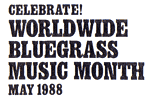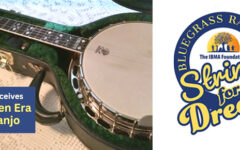 OK… so we’re a little late, but we didn’t want to let the month pass without a mention of this notable anniversary.
OK… so we’re a little late, but we didn’t want to let the month pass without a mention of this notable anniversary.
The concept of May being Bluegrass Music Month is probably buried deep in the mind at the moment, since it has been a part of the bluegrass landscape for several years now. Well, there isn’t any reason why the idea shouldn’t be reviewed and, if need be, the concept re-enforced.
World Wide Bluegrass Music Month [WWBGMM], to give its full name, was a concept presented by bluegrass music enthusiast Bob Wolff during a meeting at the International Bluegrass Music Association [IBMA] World Of Bluegrass [WOB] convention in Owensboro, Kentucky, in September 1987.
The first time in which Bluegrass Music Month was celebrated was May 1988, 20 years ago this month.
Wolff had, at that time (1987), done several years of study and teaching of theatre management and audience development within the industry. One of his tools was the book In Search of an Audience by Bradley G Morrison and Kay Fliehr (1968), New York: Pitman. LCCN 68018783. It focussed on doing research and finding ways to get information to your potential audience. Audience development meant more than doing the same old things – such as placing posters strategically, newspaper advertising and radio. Another source for ideas was Danny Newman’s book Subscribe Now!, the 1977 book which was published by the Theatre Communications Group. The book outlines Newman’s unwavering advocacy for subscription-based ticket sales.
With the selling ideas that these books prompted and the pioneering work of theatre people at places like the Guthrie Theatre, Minneapolis, audiences could be and were increased. Many of these ideas are now commonplace, of course.
Wolff started thinking how audience development related to bluegrass music. Sadly, he saw an industry did not appear to be attempting to enlarge its audience. Fans at that time were either part of a family with long-time involvement in music, usually musicians, while others became intrigued by the genre because of an interest in associated music styles; people familiar with Pete Seeger, The Weavers, The Kingston Trio, the Smothers Brothers, John Hartford and Glen Campbell. Some of this latter group have found out about bluegrass concerts and festivals, but not all. So the challenge was/is to reach that group of people and encourage them to seek bluegrass activities.
What Wolff proposed was not empirical or constricted in any way. He was simply a catalyst, prompting and encouraging constructive thought and action.
In addition to the literature that Wolff dispersed, the IBMA’s International Bluegrass publication for November/December 1987 had a front-page report on what it described as an “ad-hoc project.”
Arlie Metheny brought the concept to the attention of readers of Bluegrass Unlimited in the magazine’s April 1988 edition with a good story. Not only was it concise, it was timely as it allowed a wider range of bluegrass enthusiasts to plan activities for the following month.
About this time Jim Hatlo, in his On The Beat column for Frets magazine, helped to spread the word about this campaign beyond the strictly bluegrass clientele.
Recently Bob Wolff explained his concept in this way ……
“I challenged people interested in bluegrass music to introduce the music to more and more people during the month of May through live experiences like bluegrass pick-ins at airport, shopping malls, city parks, urban squares; appearances at schools (both in classrooms and auditoriums) and through bluegrass ambassador concerts at which people would friends unfamiliar with the music, making sure there is nothing in the way of their attending. For example, perhaps they should purchase the tickets for the people they seek to introduce to the music.
I thought that if record companies and other merchants wanted to use the idea, they would do so. The idea was free, so I thought if they thought it would be good for their business they would use it.”
Of course, many ideas were taken up and are a now recognised features of the development process. In simple terms, here’s a few things that can be done.
- Get your friends and association members to put bumper stickers on their cars.
- Wear a bluegrass button during May. Remember buttons and bumper stickers stimulate conversation.
- Get a shopping center to sponsor a performance (Pick-In) at the mall.
- Get a local agricultural product supplier, bank or other business to sponsor a Pick-In.
- Get your local radio station or music store to sponsor a Pick-In.
- Get your region’s bluegrass promoters to complete their festival and concert flyers early and arrange to have them set up attractively on a table at the Pick-In.
- Get volunteers to staff the flyer table, collect addresses, and meet and greet as bluegrass ambassadors.
- Get a local store or service establishment to provide some product or service you could give away at a free drawing during the Pick-In, thus giving people incentive to give their addresses.
Since these activities were concentrated within a single month, it is easier to get media attention and many of these annual projects attract new fans each year. The exposure is meant to increase the popularity of the music, thereby creating better and more performance opportunities for bluegrass musicians.
So much for grass roots activities, Bluegrass Unlimited magazine has kept the concept in the forefront of people’s minds with a banner at the top of its cover page each May and there has been many corporate initiatives with a view to enlarging the bluegrass market place during the past 20 years. One of these was the slogan ‘Bluegrass! Pick It Up!’, devised in 1997 to entice people to listen to bluegrass. Subsequently, came the ‘Discover Bluegrass’ campaign, which replaced ‘Bluegrass Pick It Up’ as the promotional centerpiece for industry in 2002.
Individual record companies have designed their own promotional packages, some generating remarkably successful responses.
In the 20 years since the concept was first taken up, bluegrass music has enjoyed many benefits/bonuses in the form of two outstanding phenomena; firstly that surrounding Alison Krauss and, secondly, the O Brother, Where Art Thou? film.
OK, O Brother was a widespread success and millions of people were keen enough in the music to buy the CD. But Worldwide Bluegrass Music Month isn’t about such landmark events. That said, it does indicate that there is great potential for attracting those enthusiasts into main-stream bluegrass. Check interest among your work colleagues, neighbours and friends and foster that with information about where bluegrass can be heard on a regular basis and mention suitable recordings for them to sample.
What about the future? The entertainment world has changed considerably since 1988. While that list of original points still holds true, the use of the Internet offers scope for considerable advancement in communication. Some suggestions here are ….
- Use MySpace/FaceBook/LinkedIn/etc to suggest to friends that they attend a bluegrass show or check out some new music you’re enjoying online.
- Forward some YouTube videos that you feel represent what you love about bluegrass and alert some friends.
- Establish a web site for WWBGMM; creating a place where people all over the globe can post their plans for, and the successes following, the Bluegrass Month of May each year.
Ideas and suggestions are limitless. A professional approach is essential, otherwise just spread the word and promote the music; build on the foundations of the past 20 years of effort. Be creative, be expansive, work for the benefit of bluegrass.
Footnote:
In 1992, the IBMA board formally adopted May as Worldwide Bluegrass Music Month following widespread debate as to whether September (the month in which Bill Monroe was born) or some other month should be the appropriate time for the extra promotional activities.







